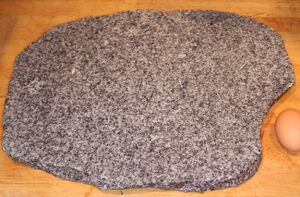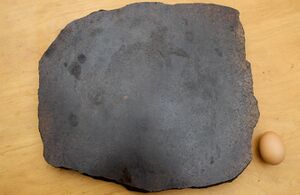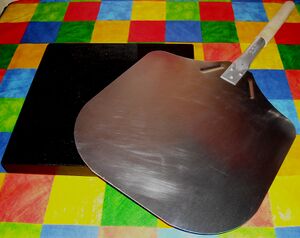
A pizza stone is a flat stone or piece of ceramic or earthenware used to evenly distribute oven heat to pizzas or other baked goods, more or less mimicking the effects of cooking a pizza in a masonry oven. The thermal mass and porous nature of the stone used also helps absorb moisture, resulting in a crisp crust.
Small pizza stones can be purchased to fit in any conventional cooking oven. High-end ovens sometimes offer optional pizza stones that are specifically designed for each oven model and may include a specialised heating element. A home made "pizza stone" can also be made by distributing one or two layers of unglazed tiles on top of an oven rack.
To prevent cracking of the stone by thermal shock, the pizza stone should be placed on a cold oven and heated over at least 45 minutes, and it should be allowed to cool down slowly inside the oven after switching it off. Because of the possibility of rapid temperature change, pizza stones should not be left in an oven while it is in self-cleaning mode.
Sprinkle cornmeal, semolina or breadcrumbs on the pizza stone to prevent the crust from sticking.
The porous nature of pizza stones does have a downside -- the stone will absorb just about anything, including soap. Use a clean, dry brush or plain water to clean the stone.
Ideal position in the oven
Have experimented with very many pizzas over the years I find that having the surface of the pizza stone about 8cm (3") from the grill element gives the best results. It allows for the ingredients like cheese and salami to crisp nicely without overcooking or burning the exposed pizza base. When using a preheated pizza stone I always pre-cook our pizza bases for a few minutes on the bottom-side before flipping, adding the ingredients and finally cooking for 3 or 4 minutes.
-
Un-trimmed granite pizza stone - £3.00 B&Q (Garden section)
-
Trimmed pizza stone after 5 years use and 100's of delicious pizzas. £3.00 well spent!
-
Baking stone and peel from Bakery Bits
Baking stones
A baking stone is a flat stone that may be used when baking. Food is put on the baking stone, which is then placed in the oven, though sometimes the stone is heated first. Baking stones are used much like baking trays, but may absorb additional moisture for crispier food. Due to the thermal properties of the stone used, food is less likely to burn when using a baking stone than when using a baking tray.
The black granite stone illustrated to the right, which is from Bakery Bits, is wonderful. However, it is very heavy indeed and if you have a problem with lifting, then you may wish to consider an alternative.
Budget pizza stone
The polished granite "pizza stone" shown was purchased from the garden section of B&Q (£3.00 - February 2009). Take a wire-shelf from the oven with you, to ensure it will fit your oven. Also be aware that you may need to check the thickness of the stone if it has to slide in between guides. Ours needed a little trimming though it is fairly easy to nibble bits off with a cold chisel. That said, there was a palette full of them and they were all different sizes so you're bound to find one that will fit.
And having just used it for the first time with a calzone and a conventional pizza, I can thoroughly recommend it. The bases of the pizzas were crunchy and not all damp - spot on!
Update
We've now been using the homemade pizza stone for 5 years and made hundreds of pizzas using it. Perfect every time. I could not conceive making pizzas any other way now.
See also
Find recipes that contain 'Pizza stone'
#pizzastone #pizzas #bakerybits #pizza #cookingmethods #pizzarecipes #cheese #breadcrumbs #calzone #salami #semolina


